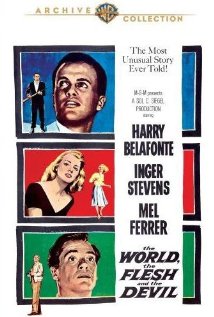A well-mounted, ambitious end-of-the-world epic, “The World, the Flesh and the Devil” thankfully has more going for it than most of the cheapjack sci-fi prevalent in the 50s, but, alas, it fails to live up to its early, exciting premise.
Harry Belafonte portrays miner Ralph Burton who appears to be the only survivor of some above-ground nuclear gas explosion. The first part of the movie focuses entirely on Ralph scouring the desolate streets of a debris-filled, obliterated New York City in search for other human life. These early scenes are quite tense and fascinating as Ralph is forced to come to fateful grips with his total isolation and lifeless surroundings. There are lighter, even amusing moments interspersed with the potentially heavy-handed theme as Ralph quite bizarrely sets up a makeshift household for himself and plays “mind games” in an attempt to break the utter monotony of loneliness and preserve his sanity. In the meantime, to keep productive Ralph tinkers around his big city “shop” with newly-found gadgets and radio hardware in a dire effort to communicate with other possible survivors. A bit mystifying though is why we don’t see any remnants of human existence anywhere and why everything else…stores, automobiles…are still standing, even in tact, for the most part. Did all signs of humanity just evaporate? Was this a selective nuclear explosion?
Enter lovely, timorous Inger Stevens as Sarah Crandall (the Flesh in the title?), a second survivor, who has been secretly following Ralph but fearful, until now, to make contact. Intriguing conflicts set in immediately as Sarah is white and Ralph black. Knowing they have only each other in the world, they endeavor to break the delicate barriers of fear that distance them.
So far so good. But then the plot takes a turn for the worst with the arrival of a third survivor (the Devil in the title?), villainous Benson Thacker, played here by Mel Ferrer, and the movie becomes a silly, ludicrous romantic triangle. Interest literally explodes and burns as fast as you can say “nuclear war.”
In a disappointing, poorly-scripted climax, the men get involved in a deadly cat-and-mouse game with Belafonte and Ferrer vying for the affections of Stevens, gunning for each other on isolated streets and lurking around buildings “High Noon” style. Here we have three mature people, supposedly the only humans left on earth, and they want to knock each other off in order to get the girl! And the final scene is unintentionally laughable. Why they chose such a cop-out ending will always be a mystery. Granted, this move was shot in 1959 and so the racial issues naturally had to be skimmed over. But since they introduced it in the first place by casting Belafonte and Stevens, why not deal with it? With a little more care and originality, they could have scaled new heights and made a daring, confrontive, ground-breaking classic.
Nevertheless, the good points outweigh the bad. Belafonte is terrific especially in his early scenes and Miss Stevens registers quite strongly during their tense exchanges. Most of all, director Ranald MacDougall captures a barren, decimated-looking New York City to awesome, jaw-dropping effect. His huge, looming, shadowy panoramic shots of a deserted Manhattan is a marvel of creativity and cinematography…an incredible feat that is alone worth the price of admission.

